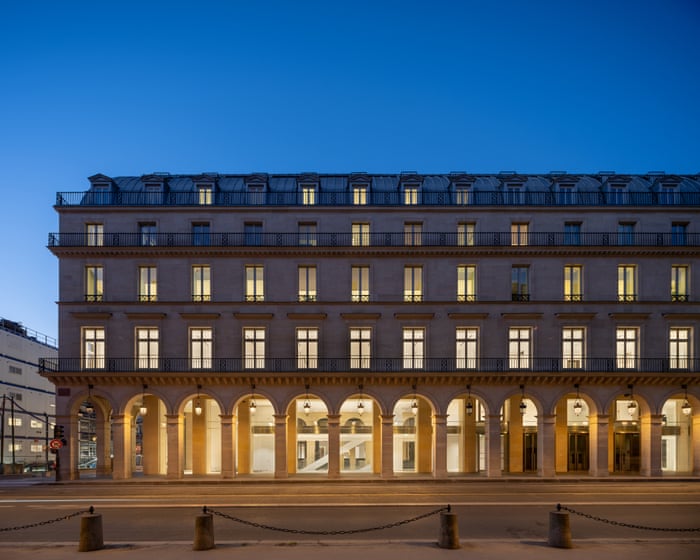No matter what happens, Jean Nouvel will always have Paris. Since the early 1980s, the City of Light has been both the stage and playground for French architecture’s formidable veteran. But the building that first made him famous—the Institut du Monde Arabe, a shimmering, intricate metal structure fitted with mechanical lenses to control light—feels worlds apart from the confusion that greeted his last Paris project, finished ten years ago.
That was the ill-fated Philharmonie, a massive trophy concert hall that the Guardian described as looking like “a pile of broken paving stones” and “a mashup of dictators’ greatest hits.” Nouvel might agree, since he skipped the building’s opening, upset by budget cuts and design changes (known in the industry as “value engineering”). He called his project “sabotaged” and the unfinished concert hall a “counterfeit.”
Despite harsh criticism, Nouvel remains defiant—an auteur who delights in creating architecture that is always dramatic and never repetitive. There is no single “Nouvel style.” As he once said, “I’m not a painter or a writer. I don’t work alone in a room. I work in different cities with different people. I’m more like a filmmaker who tackles completely different subjects.”
So what should we think of Nouvel’s latest “film”: a new home for the Fondation Cartier? This private art foundation, founded in 1984, is dedicated to collecting, displaying, and creating contemporary art. It’s now based in a renovated 19th-century building in the heart of upscale Paris, just across the street from the Louvre.
From the outside, there isn’t much to see. Occupying a full city block, the building is a classic example of Haussmann-era Paris—a massive, five-story block of honey-colored stone with a mansard roof and a colonnade that stretches monotonously along the Rue de Rivoli.
Originally opened in 1855 as the Grand Hôtel du Louvre, it was built to host visitors and exhibitors for the first Paris Exposition Universelle, a world’s fair conceived by Napoleon III to rival London’s Great Exhibition of 1851. Later, it became a department store, the Grands Magasins du Louvre, fueling France’s growing consumer society. As a bustling micro-city and precursor to the modern shopping mall, it operated for nearly a century, shaping Parisian culture and social life.
In terms of street presence, this is likely Nouvel’s most understated building to date. The only standout feature is the gold Fondation Cartier logo discreetly placed across the main facade on the Place du Palais-Royal, like an expensive necklace. A long steel and glass awning, a silver contrast to the gold, extends along Rue Saint-Honoré, offering a modern take on the historic colonnade. The honey-colored stone has been carefully cleaned and polished, and elegant new windows added at street level. The overall effect is one of seamless, understated luxury, reminiscent of an Apple store or a five-star hotel.
Nouvel’s connection with Cartier goes back to the early 1990s, when he designed a watchmaking facility in Switzerland. He was later given the more glamorous job of creating a new arts center for the Fondation in Montparnasse, in Paris’s 14th arrondissement—a social backwater compared to its current prime location.
Still, Nouvel delivered a crystalline creation of steel and glass, subtly challenging the “white cube” as the default look for contemporary art. Galleries were no longer closed-off boxes but transparent display spaces opening onto a garden and the city beyond. Marked by an uncharacteristic…Despite its formal restraint and precision, the building remains one of his most memorable works. For the Fondation’s latest transformation, Nouvel was presented with an existing historic structure but still found a way to express his subversive side.
“Here, it’s possible to do what can’t be done elsewhere,” he explains, “by changing how we display things.” Behind the building’s polite and sober exterior, the interior has been completely redesigned around five modular, movable platforms. These allow for instant reorganization of the space and new ways of presenting objects.
This ambitious approach is unprecedented. It challenges the traditional view of galleries as static boxes or a series of connecting rooms, opening up exciting possibilities for curators and artists to rethink the act of displaying art and play with scale, contrasts, and sightlines.
Built where internal courtyards once stood, the platforms range from 200 to 340 square meters. Each can be raised or lowered across three floors using cable mechanisms at their corners, with retractable guardrails ensuring visitor safety. True to the project’s overall style, the platforms are elegant rather than showy, often blending into the background. Their real impact lies in how they shape the space, putting architecture at the service of art.
“The platforms reflect the building’s historical spirit,” says Béatrice Grenier, co-curator of the opening exhibition. “They echo the mid-19th century, when mechanical modernization began in cities—think of the Eiffel Tower, elevators, and integrating mechanics into brick and stone architecture.”
Much of the original 19th-century structure was destroyed when a Lancaster bomber hit the building in 1943, giving Nouvel freedom to redesign the interior. A row of massive concrete columns from a 1970s renovation still stands, now appearing like ancient relics in the vast space.
To mark its new home, the Fondation will revisit key moments in its history through significant artworks, exhibition fragments, and projects that have defined its identity. The exhibition, titled “Exposition Générale,” references the popular 19th and early 20th-century displays of fashion, textiles, and goods hosted by the Grands Magasins du Louvre.
Nouvel’s redesign revives the building’s historical role in Parisian culture, emphasizing visual connections, rich experiences, and innovative display. In many ways, Andy Warhol’s prediction that “all department stores will become museums” has come true.
“The Louvre is focused on objects and encyclopedic knowledge, presenting the world through cultural artifacts,” Grenier notes. “We’re saying something different: that creating exhibitions is central to culture, involving a flow of ideas with thinkers, artists, and architects, and constantly evolving.”
Unlike the Louvre, which turns its back on the street, the Fondation is open and welcoming, recalling its origins as a grand department store. Passersby on the Rue de Rivoli can stroll along the colonnade and enjoy the view.From what were once shop windows and still are today, the view captivates. Here, you might find yourself drawn to the vibrant, joyful installations of Bolivian architect Freddy Mamani or the delicate, minimalist models by Japanese designer Junya Ishigami. The range of creativity spans from outsider art to works by well-known artists—like Patti Smith alongside the Yanomami community of the Amazon—connecting visitors to styles and perspectives that stand in stark contrast to France’s collection of national treasures.
The adaptable design allows for exhibits of all sizes, from the grand to the tiny. These exhibition areas are complemented by a public café and a lecture hall, the latter drenched in Nouvel’s signature deep red, with walls, floor, ceiling, and seats forming a strikingly crimson whole.
Architects often make cryptic statements. “The future of architecture,” Nouvel declared in 1980, “is no longer architectural.” While it sounds mysterious, he simply meant that architecture should not remain an isolated field but instead draw inspiration from contemporary culture. Now, as Nouvel turns 80 and the Fondation Cartier opens its doors, his words feel surprisingly fitting. And he will always have Paris.
Frequently Asked Questions
Of course Here is a list of FAQs about how Jean Nouvel transformed the historic La Samaritaine department store into a museumcaliber destination
General Beginner Questions
1 What was La Samaritaine originally
It was a famous large department store in Paris first opened in 1870 known for its Art Nouveau and Art Deco architecture
2 Who is Jean Nouvel
Jean Nouvel is a worldrenowned French architect and a Pritzker Prize winner known for his bold and contemporary designs
3 What did he actually transform it into
He transformed it into a mixeduse complex that includes highend retail shops social housing a luxury hotel a daycare and office space The main attraction is the stunning museumlike interior and art collection open to the public
4 Why is it said to rival the Louvre
This is a figure of speech highlighting its grandeur It doesnt compete with the Louvres collection but its vast aweinspiring interior architectural significance and integration of art make it a major cultural destination on a similar scale of public impact
Architectural Design Questions
5 What was the biggest challenge Nouvel faced
The biggest challenge was respecting and preserving the historic facades and certain interior features while injecting a completely modern 21stcentury design
6 What is the most iconic feature of the new design
The most iconic feature is the undulating wavy glass facade on the Rue de Rivoli It looks like a flowing frozen wave and reflects the city around it
7 How did he blend the old and the new
He kept the original restored facades intact Inside he created a huge lightfilled atrium under a spectacular glass roof allowing the historic structures and the new sleek elements like glass walkways and escalators to exist sidebyside
8 Is there any green or sustainable design
Yes the complex includes a geothermal energy system for heating and cooling and the massive glass roof is designed to maximize natural light reducing the need for artificial lighting during the day
Cultural Practical Questions
9 What kind of art can you see there
You can see sitespecific installations commissioned from contemporary artists as well as restored historic murals and




